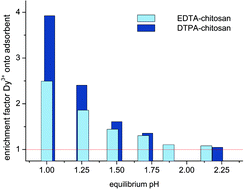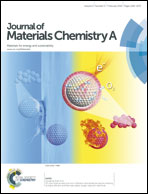Adsorption and chromatographic separation of rare earths with EDTA- and DTPA-functionalized chitosan biopolymers†
Abstract
Chitosan, which is derived from chitin by deacetylation, is one of the most promising biopolymers for adsorption of metal ions from diluted waste streams. By functionalization of chitosan with ethylenediaminetetraacetic acid (EDTA) or diethylenetriaminepentaacetic acid (DTPA) groups, it is possible to obtain a material that is much less soluble in acidic aqueous solutions than native chitosan. The coordinating EDTA and DTPA ligands are very efficient for binding of rare-earth (lanthanide) ions. The functionalization was achieved by reaction of chitosan with EDTA bisanhydride or DTPA bisanhydride. The binding of lanthanide ions to functionalized chitosan was investigated by FTIR (binding of Nd3+) and luminescence spectroscopy (binding of Eu3+). Comparison of the luminescence decay times of the europium(III) coordinated chitosan complexes swollen in water and in heavy water allowed determination of the hydration number of the coordinated Eu3+ ion. Batch adsorption tests for the uptake of neodymium(III) from aqueous nitrate solutions were performed for EDTA-chitosan and DTPA-chitosan. Different experimental parameters such as the adsorption kinetics, loading capacity and pH of the aqueous feed were investigated. The modified chitosan materials are much more effective for adsorption of rare earths than unmodified chitosan. It was shown that adjustment of the pH of the aqueous feed solution allows achieving selectivity for adsorption of rare-earth ions for mixtures containing two different ions. After stripping of the metal content, the modified chitosans could be reused for new adsorption experiments. Medium pressure liquid chromatography (MPLC) with DTPA-chitosan/silica as the stationary phase and a dilute nitric acid solution as eluent was used for the separation of the following mixtures of rare-earth ions: Nd3+/Ho3+, Pr3+/Nd3+ and Pr3+/Nd3+/Ho3+. The experiments show that separation of the rare-earth ions is feasible with DTPA-chitosan/silica, without the need for using solutions of chelating agents as eluents.


 Please wait while we load your content...
Please wait while we load your content...